|
introduced below...
Electric Transport
Electric Hubcap/Caik/Weel Motor system -
Unipolar BLDC motors.
Electric Caik Outboard.
Variable Torque Converter Transmission.
Social Issues related to Energy
Ground Effect Vehicle
Study of new concepts with novel designs for a stable, rugged and reliable ground effect craft was undertaken starting in 2017. In 2019 and 2020 construction of a 1/4 scale radio controlled model is being undertaken.
Such a vehicle, with the speed of a light aircraft but the versatility of a seaworthy marine vessel and very low fuel usage, could really open up areas which are poorly accessible by land such as scattered islands and mountainous coastlines.
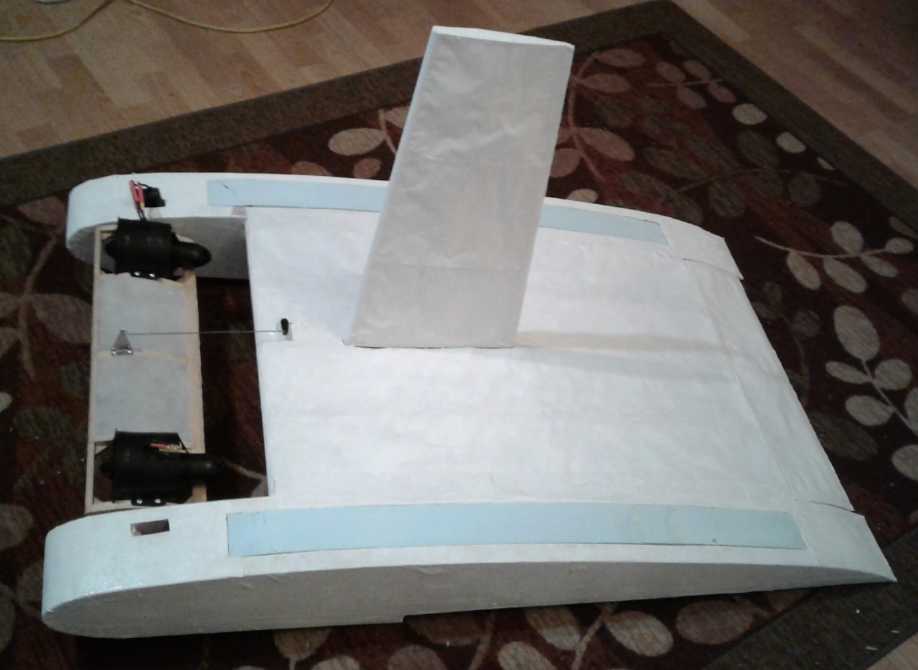
Power for the model is two 90mm ducted fan "jet" motors, left and right. Owing to lower fuel usage than light aircraft, several electric ducted fans are expected to power a full size vehicle as well.
The ELECTRIC HUBCAP Motor System
is a family of simple, efficient (~95% peak) axial flux 'pancake'
motors plus solid state motor controllers, developed with a focus on
electric transport applications but available for various purposes.
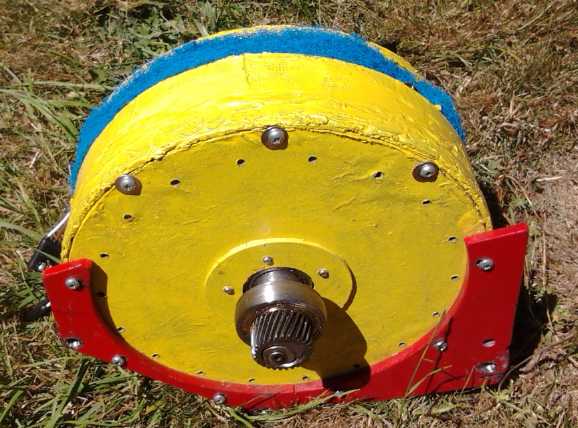
From 2008 and on into 2014 the motors went from "gosh
it works!" innovative to highly efficient to safe and reliable.
Bodies are molded from polypropylene-epoxy, a seemingly
overlooked composite that is stronger and lighter than fiberglass.
Some rough specs for the Electric Caik/Electric Hubcap/Electric Weel
motors are: 4.8/7.2/19.2 KW, 24/36/48 V, 0-200 A (x2 motor controllers
for Weel), 0-3000/-2000/-700 RPM, 9/11/28" OD, all 4-5" thick, 15/30/90
pounds. All motor sizes and styles mount the same individually made
toroidal donut coils and magnets: 6/9/24 coils and 4/6/16 magnet poles.
From 2015 new ideas in permanent magnet assisted
reluctance motor appeared that promise to be superior to most any other
type of transport motor, with unparalleled current reductions and very
high RPMs that should make variable transmissions unnecessary. Some of
the techniques and components created for the Electric Hubcap
series are applicable to this new and better type. A first test motor
with controller has been created, but further development is required.
The ELECTRIC CAIK Outboard
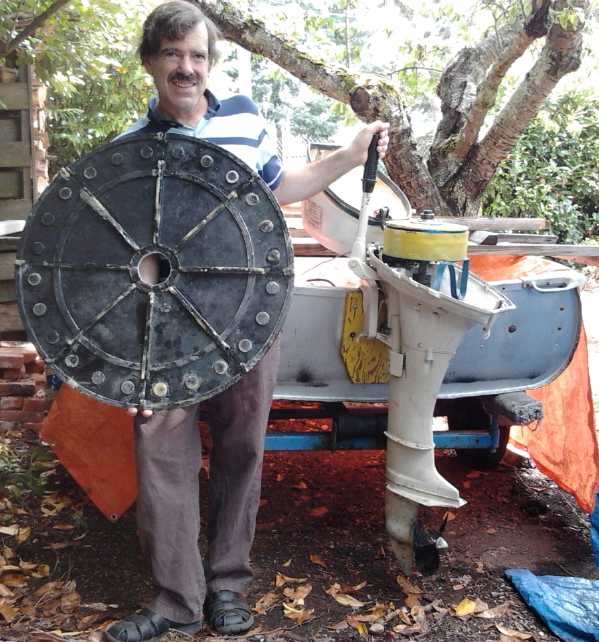
The 2 KW Electric Caik is the smallest motor of the family.
It fits in this Honda 7.5 outboard, and has taken the boat out on the
ocean. So far (fall 2014), this has been the only really successful
transport application of the motors. The torque of the Electric Weel
motor, the largest (inside of stator end cover at left), is immense
owing to all the motive elements being at the outside of a 26" flat
rotor.
The PLANETARY GEAR VARIABLE TORQUE CONVERTER
TRANSMISSION
The Electric Hubcap drive motor was originally conceived as an
add-on accessory wheel mounted motor to change petroleum vehicles into
highly efficient plug-in electric hybrids to run on batteries recharged
at home. The gas engine would be started and engaged when the batteries
provide insufficient range. Since car wheels are too low an RPM and
cars too heavy to allow a wheel mounted motor to develop sufficient
power with direct drive, the motors must be 'geared down'. Various
attempts to create a suitable magnetic or mechanical variable torque
converter failed until in 2012 it was realized that using a planetary
gear and allowing one element to slip under tension increases the gear
reduction between the other two elements by any desired amount. This
allows high torque from a stop yet low RPMs at highway speeds.
Experiments showed that the mechanism only works once the gears are in
motion, so either a big flyweel is needed to get the car going as the
motor slows, or a clutch allows the gears to turn while the car is
stopped. Assembly of such a transmission with a low RPM centrifugal
clutch is underway as of fall 2014.
Sustainability and Energy Social Issues

The roadblocks for moving to friendly, sustainable energy and other
sustainable systems incorporating the seven core values of social
sustainability:
LIFE, quality of life, provision for growth, equality, empathy,
compassion and love for humanity (see 7CoreValues.org),
are largely social
in nature, and hence social considerations are inseparable from any
discussion of green energy. In the "In Passing" section of various
newsletters, issues are discussed such as our antiquated and unevolving
'dead end' institutions and increasing usurpation of control of them by
self-serving manipulative, unbalanced and socially insensitive
personalities (AKA gangsters and banksters), the coming financial,
economic and population collapse, the corrupt patent system, the need
for a Department of Progress to provide for ongoing evolution
of governmental institutions, and many other topics. (See HandsOnDemocracy.org
)
|
introduced below...
Energy Storage
New Chemistry Batteries Ni-Mn & Ni-Ni,
Lead-Acid Battery Renewal,
Large Ni-MH Batteries from "D" Dry Cells.
Open Loop Air Heat Pumping ("OLAHP")
Or, how to heat a house almost for free!
COP=10 in freezing weather?
Energy Production
Ocean Wave Power, Nanocrystalline titanium
borosilicate transmissive glaze for solar panels, VAWT.s,
Thermoelectric Generators,
Floating Hydro, HE Rays, Magnet Machines.
Other Green Energy Projects/Products
Low voltage Wiring for "off-grid"
installations, Better LED Lighting (flat panel - globe - greenhouse),
Thermoelectric (Peltier module) refrigeration and heat pumping.
Author's Other Interests
The Turquoise Battery project
aims to develop good, economical batteries with
high energy density for off-grid use or low cost grid level storage. A
number novel techniques and chemistries have been explored.
From late 2023 an exciting
"new" combo, zinc and copper ("Cu-Zn") in neutral salt solution is
being developed. Zinc dendrites have been eliminated for "forever"
cycle life. Copper is charged to a previously unexplored form, copper
oxyhydroxide (valence III, so moving up to three electrons per copper
atom) and with these low cost, high energy materials 200-300
WH/Kg may well be expected for large cells. Monel has been found to
not corrode away in copper positive electrodes, allowing metallic
current collectors instead of graphite/carbon based.
Previously explored novel salt solution chemistries
include "nickel manganates" or nickel-manganese oxides for positive
electrodes, wherewith the manganese oxide becomes rechargeable, and
two trace additives allow a -1.5 volt manganese negative electrode
to hold its charge, which has never been accomplished before. Two
high voltage electrodes together give a Ni-Mn cell the highest
voltage of any water based battery cell, as high as 2.4 volts
Open Loop Air Heat Pumping
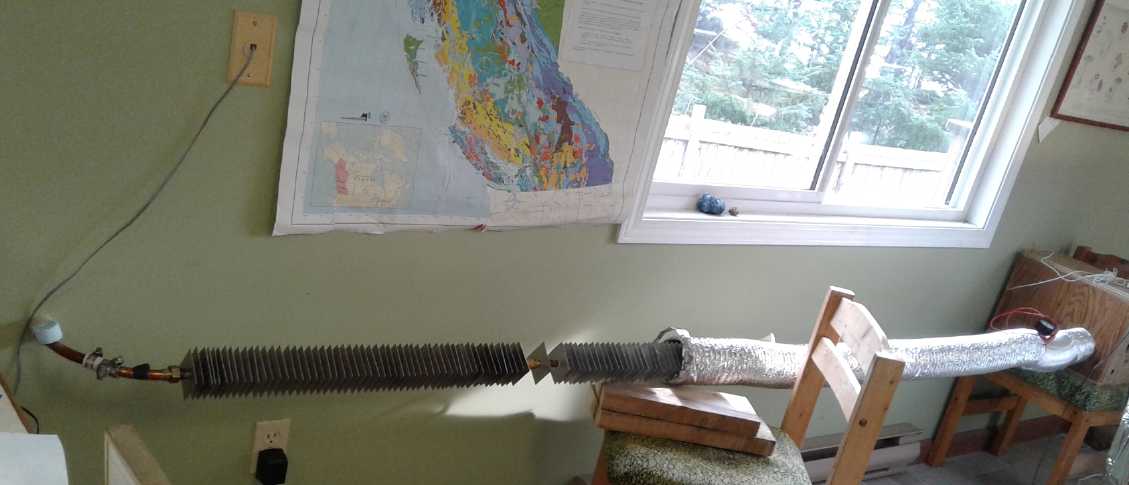
A new concept for 2020, a passive outdoor heat exchanger provides most of the temperature "lift", while the air compressor and radiator system only adds a few degrees, making possible fantastic coefficients of performance almost regardless of outdoor temperature - 1000 watts of heat for 100 watts of electricity is just a starting point!
Generating Power
Various designs to extract more power from flowing water,
waves and wind are described in Turquoise Energy News newsletters.
Nanocrystalline titanium oxide borosilicate glaze
for solar cells
Frit of this glass would be sprinkled onto the
cover glaze, which is
then re-fired enough to melt the frit into little pebbly lenses on the
surface, which would then reflect much less light and better refract it
downward into the light sensitive components.
These could potentially up the daily solar energy capture
of solar cells by 25% or more by capturing more light from more oblique
angles.
Other Green Energy Projects & Products
Low Voltage House Wiring Systems
Renewable energy,
"off-grid" systems, motor homes and boats, and the proliferation of low
voltage electronic devices are crying for standardized low voltage
DC wiring systems, especially 12 VDC systems. To this end 3D printed shells and wall plates for "standardized" 12 VDC plugs and sockets employing "T-Plugs" (for 36V) and "Mini-T-Plugs" (for 12V) have been created. In these the "+" pin is turned sideways (the "T") so DC appliances can't be plugged in backward.

There are 12 and 36 Volt plugs, sockets, wall plates for standard electrical boxes,
and click-lock plugs and sockets. (36/40 volts is considered to be the optimum
DC building distribution voltage, with thinner wires and lower currents than 12 or 24 volts but still essentially electrocution-safe.)
LED Lighting LED Indoor Garden
The old "light bulb" format is not very
suitable for low voltage solid state
LED lighting. From 2011 diffused globe lighting was produced (base
shown), but proved uneconomical as made.
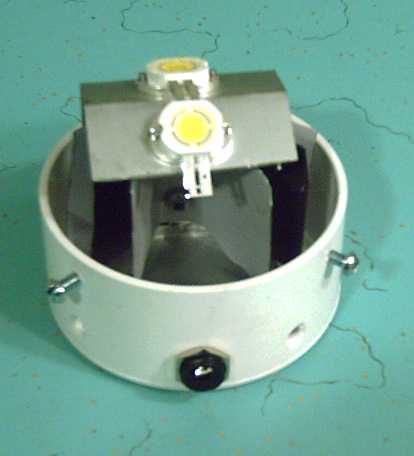 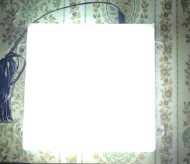
Flat panel LED lights were prototyped which
take up a low profile and give more even light. However the low cost of
commercial LED lighting bulbs and fixtures led to setting the project
aside in about 2015.
For 2018 a new LED Indoor Garden product idea is being tested,
successfully growing lettuce and other greens in winter.
Author's Other Interests
Our Solar System: Living Titan
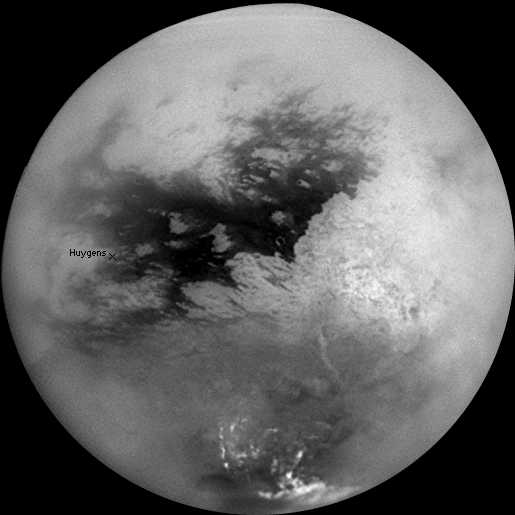
My own studies (2005-) of the astonishing living world that the Cassini and Huygens mission to Saturn revealed, but which the space scientists involved completely misunderstood two of the most prominent aspects of.
The Supercorder ("Super" Recorder)

From 2003 to 2006 I created a beautiful new woodwind instrument, a recorder (blockflute/beakflute/sweetflute) loud enough and verstile enough to play with other modern "orchestral" instruments and with a beautiful recorder tone all its own.
I have played it in amateur orchestras and concert bands as well as small ensembles.
|